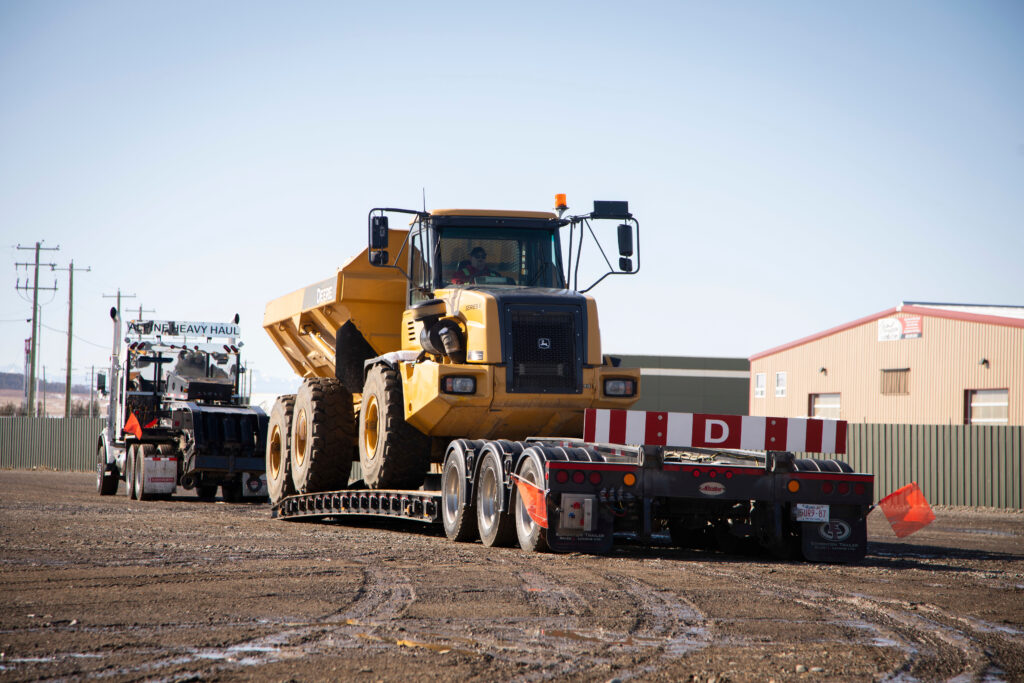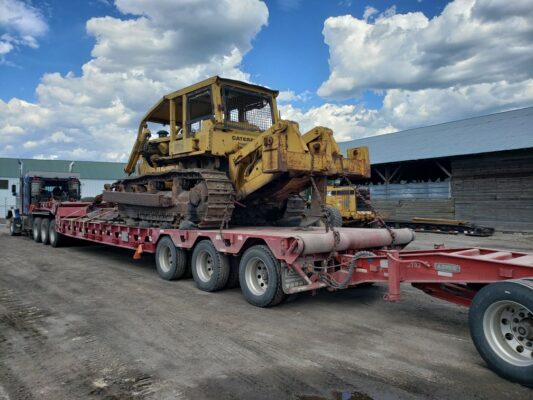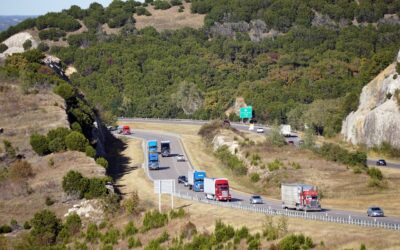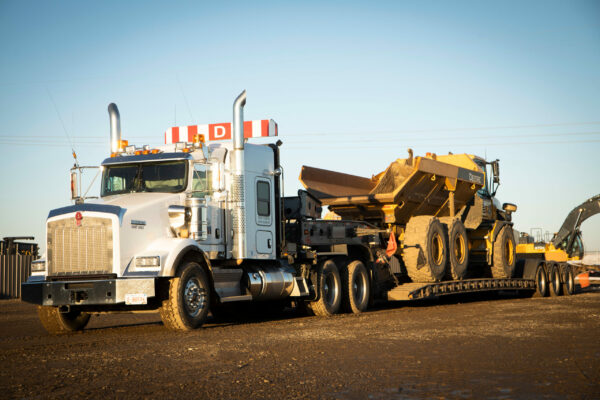9 Heavy Haul Terms Shippers Need to Know
Many industries, such as the heavy haul transport industry, have very specific keywords and terms. When entering this industry or hiring someone from within this industry, it’s important to understand or at least be aware of some of these key terms. You may come across particular words or terms that are unfamiliar to you until you need to ship a piece of heavy equipment. You may encounter these terms in documents, in communication with a driver, or while exploring which company to hire for transport. Knowing the basic lingo of an industry can help you better understand how the process works and ask the right questions when needed.
Why You Should Learn Your Heavy Haul Terms
Heavy haul transport has a variety of important terminology and names that you may want to know when transporting. Some of these terms include:
- load securement
- roll-on and roll-off
- load board
- removable gooseneck (RGN) trailer
- low-boy trailer
- over-sized load
- long haul
- head haul
- Backhaul or deadhead
Most of these terms are not something that you may hear in your everyday vocabulary, but they are important to know when transporting heavy haul equipment. The following descriptions will tell you more about each of these terms and why it is important that you familiarize yourself with them. To learn more about them, what they mean, and heavy haul transport, read on.
Load Securement
Load securement is a method in which cargo is secured during transport. It can also be described as how the driver secures your freight to the trailer using tools such as chains and rachets. Aside from the literal meaning of load securement, there are a few legal rules that must be followed to do this properly. Some of the rules will include how many tie-downs a load will need to be properly secured or the required strength of tie-downs depending on the weight of the cargo. Some rules will vary, depending on your location, but they are generally similar in many different regions. It is important that your driver follow the legal rules and regulations regarding load securement. When you are shipping with us at Trusted Dispatch, your driver will know all the ins and outs regarding load securement, so you don’t have to worry.
Roll-on and Roll-off
A load board can be compared to a community bulletin board or a company task board. It notifies everyone of updates and tasks as well as keeps everyone informed. Shippers will describe what they need to be hauled, where they need it hauled from, where they need it to end up, along with the ideal time of its arrival. After they have described these factors, they will post the load to the “load board.”
Another important term is called roll-on and roll-off. This is how large equipment is loaded onto a trailer. Most, if not all, trailers for heavy haul transport have ramps that allow the machine to drive right onto the trailer, making this task simple and low-stress. Your driver will know how this works and if the truck or trailer has this ability. If the trailer has wheels or a track, you will most likely notice this term being used. Ultimately, this term is pretty simple and straightforward as it comes from the fact that freight or cargo can literally be rolled on the trailer and rolled off the trailer.
Load Board
Drivers will also monitor the load board for jobs that suit them. When a driver sees something they can haul, they will claim it and reach out to the shipper. All of this is done on a load board. At Trusted Dispatch, all communication is facilitated through a well-managed load board that makes it easier for customers to find drivers and drivers to find easier loads.
An added benefit of a load board, such as Trusted Dispatch, is that your payment is held securely until the delivery is verified as completed. There are no extra fees the way a broker might charge, and you have peace of mind that your driver is trustworthy.
Removable Gooseneck (RGN) Trailer
A removable gooseneck (RGN) is a type of trailer that detaches from the truck at the front end using a hydraulics system. After it detaches, it acts as a ramp for machines to drive on from the front of the trailer. RGNs are most suitable for heavy loads, long loads, and wide loads.
RGNs also help with drivers when shipping or hauling heavy-duty equipment. They allow you, or whoever is handling your shipment, to drive the equipment onto the trailer, ship the equipment efficiently and securely, then drive the equipment off the RGN at the destination of the shipment. What an RGN does is make the lives of drivers and carriers easier as they remove the need to have cranes and forklifts when loading or unloading equipment.
Low-Boy Trailer
A low-boy trailer can be understood based on its name; it is low to the ground. It can also be called a double-drop, low-bed or float trailer. The low-boy trailer normally sits 24 inches above the ground. The reason this type of trailer is so low to the pavement is due to two drops, one behind the gooseneck and one before the rear wheels. The height, as well as the capacity of the low-boy trailer, is one of its most important attributes, as it is optimal for tall and heavy loads. The low-boy trailer can also come in step-deck, single-drop, or double-drop styles to accommodate various load combinations. When shipping and hauling heavy-duty equipment such as excavators, tractors, front-end loaders, and industrial equipment, low-boy trailers do the job. At Trusted Dispatch, we will inform you what trailer suits your needs and cargo the best, which in some cases could be the low-boy trailer.

Oversized Load
An oversized load may seem self-explanatory, but there are a few specifics to keep in mind. Oversized loads include any load that exceeds regulations in height, width, length, or weight. For an oversized load, you must have a permit before hauling, and you must display signage to indicate that it is oversized.
When travelling with an oversize load, you will most likely have to use flags or lights on the truck, trailer, or tractor. Normally the flag or light will need to be red or amber in colour. Having this displayed ensure’s that the load is visible to other drivers travelling on the road both during the day and at night. Travel escorts or pilots also will require flags or lights displaying the oversize load.
There are certain restrictions on routes that you can travel with an oversized load that can include the time of day you can travel with it. Much of the time, an oversize load will not be able to travel in the dark and will only be able to when it is light out. Additionally, many oversize loads cannot travel during weekends or holidays. This sometimes can cause extra work for a trucking or heavy haul company as they must carefully plan out their routes and travel times with these considerations in mind.
Oversized loads also sometimes require a pilot or escort cars. Many companies will cover hotels and certain costs for these escorts, which would be included in the overall cost of shipping. Escort or pilot trucks can be extremely important when it comes to oversized loads. If necessary, they will warn the truck drivers about issues on the road. This may include any kind of traffic jam, accident, or construction zone.
Long Haul
A long haul is a shipment that requires more than one day of travel. Long haul shipments are actually quite common when shipping across Canada as well as fairly common when shipping across the border. However, this is not always the case. If you are shipping from somewhere like Montana to Alberta, this could be considered a shorter trip, whereas shipping from somewhere like Texas to Alberta would be a long one.
Those who are considered long-haul truck drivers will travel with different truck and trailer combination vehicles. They will also oversee freight loading and make sure that the cargo weight limits are not exceeded. All the cargo will be secured properly with the oversight of long-haul truck drivers, which will help prevent damage to the freight.
Head Haul
A head haul is essentially a load that is travelling to its destination. So, when trucks are heading to a destination with cargo or a load on their truck, this is called a head haul. The head haul is the first part of any route where a driver has a load to deliver. A head haul can be considered the first leg of the journey. Drivers will usually have the most volume or cargo during the head haul and, therefore, the highest revenue during this time. Sometimes drivers do not always have a load on their return trip, wherein this would be referred to as the backhaul. However, drivers almost always will try to have cargo or freight during the backhaul as it is a more profitable and worthwhile trip.
The head haul market itself can be characterized by the demand for shippers exceeding the supply of cargo. When this market is high, there are many choices for carriers, cargo or freight shipping rates are relatively high, and shipping is in favour of carriers.
Back Haul or Deadhead
As previously stated, the head haul is the first part of the trip, and the backhaul is the last part, or the return trip for a driver, following the same route as the head haul. The backhaul can sometimes be empty or have more space to accommodate extra loads. It is useful to know that driving a backhaul requires the same amount of resources, skill, and hours as a head haul and is just as important. At times, some people will mistakenly think they can get a backhaul at a cheaper rate than a head haul due to the lack of cargo. At Trusted Dispatch, we always pay drivers fairly for time, expertise, and equipment. Working with Trusted Dispatch assures shippers fair rates, which can often be lower than other heavy haul companies, but it is not due to taking advantage of backhaul loads or of drivers. For the most part, drivers will try to fill their trailer and be useful for the return trip, as opposed to returning with no cargo.
The market for backhauls is slightly different than head hauls. Carriers have fewer options that they can get out of this market. Sometimes they have to be willing to negotiate the price of the backhaul rather than travel back to their original destination empty. The shipping rates of freights can actually be lower for shippers during the backhaul as well.
Deadhead
When a driver travels during the backhaul with no cargo and their trailer is empty, this is called a deadhead. Sometimes this will occur when a driver has to travel this way because they are travelling to a destination to start a new head haul. This also occurs when drivers return from a head haul without any cargo. A Deadhead is a worst-case scenario since it implies a loss of money for carriers. They are also bad for drivers as they can be dangerous as the truck weighs much less than with freight on it. This loss of weight can mean the truck is not held down by the weight of cargo which can cause problems if the weather is hazardous. Drivers will avoid deadhead trips whenever possible.
Heavy Haul Transport in Canada and the United States
It is important that you feel prepared when inquiring about heavy haul transport, and knowing these terms can help you with that. Terminology is very important when inquiring about heavy-haul shipping. The previously discussed terms demonstrate that there are regulations and rules that must be followed as well as hazardous issues that must be considered.
Regardless of the importance of these terms, at Trusted Dispatch, our goal is that you have the best possible experience with your heavy haul shipment. We will make sure that whatever you are shipping, whether that be heavy equipment, machinery, or an oversize load, is as simple and efficient as possible. Get a free instant quote using the calculator on our homepage, and start your heavy haul shipment process today!





